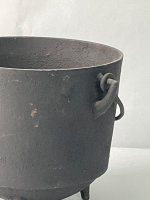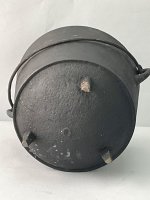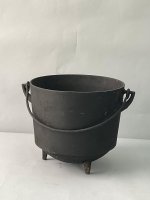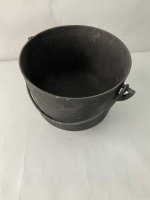Hi all, I am looking for any help in identifying the age, type, and any history of fire this kettle. I inherited this from my grandmother and I am thinking it may be 1750's. I am familiar with the term gypsy pot, however I thought those were only the bulb shape.
There is some great info here https://minuteman.boards.net/thread/61/cast-iron-gypsy-legged-older about the style, but again these are all about the bulb type, where as mine has similar elements but a completely different shape. From what we can see on my pot is that it has straight sides, triangular yet rounded legs, a visible round sprue on the bottom. There are no interior markings and the ears are only slightly upward.
Dimensions are;
height 9.5"
diameter 10.5"
legs 2"
There is some great info here https://minuteman.boards.net/thread/61/cast-iron-gypsy-legged-older about the style, but again these are all about the bulb type, where as mine has similar elements but a completely different shape. From what we can see on my pot is that it has straight sides, triangular yet rounded legs, a visible round sprue on the bottom. There are no interior markings and the ears are only slightly upward.
Dimensions are;
height 9.5"
diameter 10.5"
legs 2"




